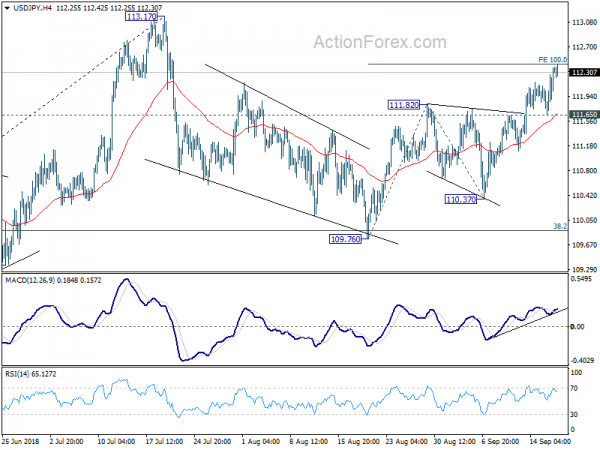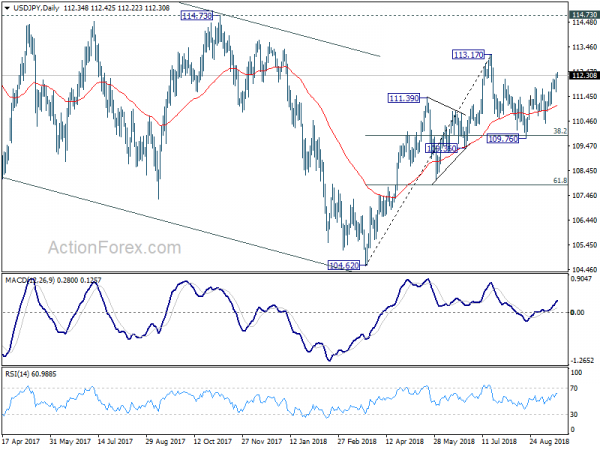Trade war escalations continue to be ignored by the markets in general. Dollar and Yen are staying as the weakest ones today. In particular, Yen is pressured additionally by sharp rally in US treasury yields over night. BoJ’s announcement to stand pat on monetary policy triggered little reactions to the Japanese currency too. On the other hand, Australian Dollar is leading New Zealand and Canadian Dollar higher. Euro firmed up slightly against Dollar and Yen but lacks conviction.
Overnight, DOW closed up 0.71% at 26246.96. S&P 500 gained 0.54% to 2904.31. NASDAQ rose 0.76% to 7956.11. Risk appetite continues in Asian session with Nikkei trading up 1.28% at the time of writing. Hong Kong HSI is up 0.97%. Singapore Strait Times is also up 0.60%. Even China Shanghai SSE is up 0.97% at 2726, back above 2700 handle. Gold is up slightly at 1201 but lacks momentum to take on 1214.30 resistance.
Technically, EUR/USD still fails to break through 1.1733 resistance so far. Recovery is seen in USD/CHF while GBP/USD lost momentum after hitting 1.3165 projection level. There is prospect a pull back in European majors today. On the other hand, AUD/USD broke 0.7228 minor resistance while USD/CAD broke 1.2975 minor support. This suggests that commodity currencies are picking up more strength.
30-year yield to take on 3.255/260 key resistance
US treasury yield staged strong rally overnight, in particular at the long end. 5-year yield closed up 0.034 at 2.936. 10-year yield rose 0.047 at 3.048. 30-year yield rose 0.057 to 3.195. The development is certainly welcomed by Fed policy makers who are worried about flattening yield curve. The development also put extra selling pressure on the Japanese Yen.
30-year yield (TYX) could take on key resistance level at around 3.255 soon. That’s in proximity to 61.8% retracement of 3.976 to 2.102 at 3.260. The rebound from 55 week EMA carries bullish implications. But decisive break 3.255/260 is needed to confirm underlying momentum. In that case, we could seen TYX head towards 3.976 or even 4.000 handle in medium term.
BoJ kept short term rate at -0.10%, asset purchase as JPY 80T pa
BoJ left monetary policies unchanged as widely expected. Short term policy interest was held at -0.10%. BoJ will also continue with JGB purchase to keep 10 year yield at around 0%, but allow it to “move upward and downward to some extent”. Annual pace of monetary base expansion is kept at JPY 80T. The decision was made by 7-2 vote. Harada opposed again on allowing yield to move in a range as that’s “too ambiguous” as guideline. Kataoka continued his push to “strengthen monetary easing”.
The central bank expected the economy to “continue its moderate expansion”. Domestic demand is likely to “follow an uptrend”. Exports are expected to continue the “moderate increasing trend”. CPI is “likely to increase gradually toward 2 percent, mainly on the back of the output gap remaining positive and medium- to long-term inflation expectations rising”
Risks to outlook include US macroeconomic policies, consequences of protectionist moves, developments in emerging and commodity-exporting economies, Brexit and geopolitical risks.
China announced retaliation, 5-10% tariffs on $60B US imports effective Sep 24
China formally announced its retaliation tariffs yesterday, in quick response to the tariffs on USD 200B in Chinese imports announced by USTR earlier in the week. In short, the tariffs will be effective at 12:01 local time on September 24. Total amount of American good involved values at USD 60B, Tariff rates are at 5% and 10%, much lower than prior proposed 5-25%.
China’s announce was made through the Ministry of Finance. 2493 lines of products in Annex 1 and 1078 lines of products in Annex 2 will be subject to 10% tariffs. 974 lines in Annex 3 and 662 lines in Annex 4 will be charged 5% tariffs.
China state media said trade war is an opportunity
A front page article in China’s official People’s Daily newspaper said that the country is not afraid of “extreme measures” of the US regarding trade war. The article urged that “to deal with the trade war, what China really should do is to focus on doing its own thing well.” It also said China should use the situation “as an opportunity to replace imports, promote localization or develop export-oriented advanced manufacturing.”
Another official news paper China Daily also said “the trade conflict will not force China to succumb to US pressure. Instead, given its economic resilience, it will squarely face those challenges, find the right solutions, and emerge stronger.”
UK PM May urged EU to evolve its position on Brexit agreement
UK Prime Minister Theresa May wrote in Die Welt newspaper that the agreement on an orderly Brexit is close be concluded. She said, “we are near to achieving the orderly withdrawal that is the essential basis for building a close future partnership.”
However, May also urged that “To come to a successful conclusion, just as the UK has evolved its position, the EU will need to do the same. Neither side can demand the unacceptable of the other, such as an external customs border between different parts of the United Kingdom.”
EU chief Brexit negotiator Michel Barnier also said yesterday that they “ready to improve” the Irish border backstop proposal. He added that “we are clarifying which goods arriving in Northern Ireland from the rest of the U.K. would need to be checked, where, when and by whom these checks would be performed.”
BoE Vlieghe: Wage growth still happening quite slowly
BoE Gertjan Vlieghe said in an interview with the Newcastle Journal that wage growth is “still happening quite slowly”. And he pointed to 2% wage growth for “a couple of years” and its now “at about 2.5% or 3%” only.
He noted “the general idea is an old one that is still valued”. That is, “at some point the unemployment rate is low enough that it gets increasingly difficult for employers to find workers or keep the ones they have.” He pointed to unemployment rate at 43-year low, “reports of skills shortages” and “job turnover” at a cyclical high. And that ” creates pay pressures as their companies try to attract employees and stop their own from leaving”.
But such development “has happened later in the process” and “it is only in 2017 we have been starting to see that.” He added one of the reasons was that employers did not reduce compensations during the financial crisis. Additionally, many people are classed as under-employment, showing that they’re only working part-time. Employment had turn to other method to compete for talent rather than just high pay.
EU releases proposals on WTO reforms, defend multilateral trade system
European Commission released their comprehensive approach for the modernisation of the World Trade Organisation yesterday .
In presenting the ideas, Commissioner for Trade Cecilia Malmström said: “The multilateral trading system has for the past decades provided a stable, predictable and effective framework for companies across the world, helping many economies to grow rapidly. Also today, the WTO is indispensable in ensuring open, fair and rules-based trade. But despite its success, the World Trade Organisation has not been able to adapt sufficiently to the rapidly changing global economy. The world has changed, the WTO has not. It’s high time to act to make the system able to address challenges of the today’s global economy and work for everyone again. And the EU must take a lead role in that.”
The ideas in the proposal are related to three key ares:
- updating the rule book on international trade to capture today’s global economy
- strengthening the monitoring role of the WTO
- overcoming the imminent deadlock on the WTO dispute settlement system.
EU also noted that the US and Japan are engaged in the framework of trilateral discussions. A dedicated workgroup was set up during the latest EU-China summit. And EU pledged to discuss the ideas with other WTO partners in the coming weeks.
Here is the press release. And a 17-page document detailing the proposals.
On the data front
New Zealand current account turned into NZD -1.62B deficit in Q2. Australia Westpac leading index rose 0.1% mom in August. Japan trade deficit widened to JPY -0.19T in August.
Looking ahead, UK inflation data will be the main focus today. Headline CPI is expected to slow from 2.5% yoy to 2.4% yoy. Core CPI is also expected to slow from 1.9% yoy to 1.8% yoy. RPI, PPI and house price index will also be released. Eurozone will release current account.
Later in the day, US current account, housing starts and building permits will also be featured.
USD/JPY Daily Outlook
Daily Pivots: (S1) 111.88; (P) 112.15; (R1) 112.63; More…
USD/JPY rises to as high as 112.42 so far, just below 100% projection of 109.76 to 111.82 from 110.37 at 112.43. Intraday bias remains on the upside. Sustained break of 112.43 will pave the way to retest 113.17 high. On the downside, break of 111.65 support is needed to indicate short term topping. Otherwise, further rise is expected even in case of retreat.
In the bigger picture, corrective fall from 118.65 (2016 high) should have completed with three waves down to 104.62. Decisive break of 114.73 resistance will likely resume whole rally from 98.97 (2016 low) to 100% projection of 98.97 to 118.65 from 104.62 at 124.30, which is reasonably close to 125.85 (2015 high). This will stay as the preferred case as long as 109.36 support holds. However, decisive break of 109.36 will mix up the outlook again. And deeper fall should be seen back to 61.8% retracement of 104.62 to 113.17 at 107.88 and below.
Economic Indicators Update
| GMT | Ccy | Events | Actual | Forecast | Previous | Revised |
|---|---|---|---|---|---|---|
| JPY | BoJ Rate Decision | -0.10% | -0.10% | |||
| 22:45 | NZD | Current Account (NZD) Q2 | -1.62B | -1.32B | 0.18B | 0.09B |
| 23:50 | JPY | Trade Balance (JPY) Aug | -0.19T | -0.14T | -0.05T | -0.10T |
| 00:30 | AUD | Westpac Leading Index M/M Aug | 0.10% | 0.00% | ||
| 08:00 | EUR | Eurozone Current Account (EUR) Jul | 22.4B | 23.5B | ||
| 08:30 | GBP | CPI M/M Aug | 0.50% | 0.00% | ||
| 08:30 | GBP | CPI Y/Y Aug | 2.40% | 2.50% | ||
| 08:30 | GBP | Core CPI Y/Y Aug | 1.80% | 1.90% | ||
| 08:30 | GBP | RPI M/M Aug | 0.60% | 0.10% | ||
| 08:30 | GBP | RPI Y/Y Aug | 3.40% | 3.20% | ||
| 08:30 | GBP | PPI Input M/M Aug | 0.40% | 0.50% | ||
| 08:30 | GBP | PPI Input Y/Y Aug | 9.10% | 10.90% | ||
| 08:30 | GBP | PPI Output M/M Aug | 0.20% | 0.00% | ||
| 08:30 | GBP | PPI Output Y/Y Aug | 2.90% | 3.10% | ||
| 08:30 | GBP | PPI Output Core M/M Aug | 0.20% | 0.00% | ||
| 08:30 | GBP | PPI Output Core Y/Y Aug | 2.10% | 2.20% | ||
| 08:30 | GBP | House Price Index Y/Y Jul | 2.90% | 3.00% | ||
| 12:30 | USD | Current Account (USD) Q2 | -103B | -124B | ||
| 12:30 | USD | Housing Starts Aug | 1.24M | 1.17M | ||
| 12:30 | USD | Building Permits Aug | 1.31M | 1.31M | ||
| 14:30 | USD | Crude Oil Inventories | -2.7M | -5.3M |















